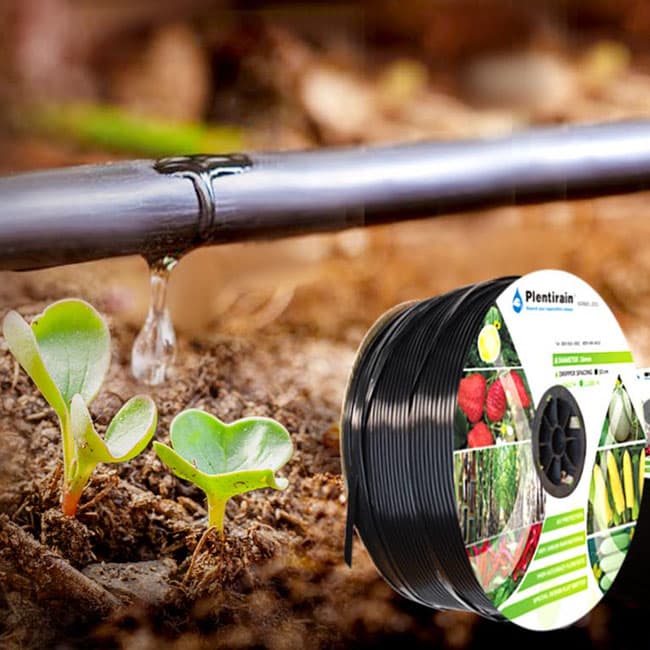1. Physical clogging. This is the main cause of drip irrigation system clogging. If the irrigation water quality is poor and the filtration system is poorly designed and installed, the debris such as sediment may be pumped into the pipeline and drip tapes/drip lines. When debris passing through the dripper labyrinth, they will block the flow channel and make the dripper clogged.
2. Biological clogging. There are two main types of bioclogging.
One is the clogging caused by the growth of green moss, algae and other microorganisms in the dripper flow channel. If the algae and other organisms are abundant in the irrigation water, the drip irrigation system is often combined with fertilization irrigation, and the light-proof facilities are not in place, which will easily lead to the proliferation of microorganisms and block the emitters.
The second is that the roots of the crops invade the drip irrigation water holes and cause clogging.
3. chemical clogging. It is mainly caused by the crystallization of chemical fertilizers or inorganic salts in water. One is that the fertilizer remaining in the drip tape may precipitate after drip irrigation fertilization, which will block the flow channel of the dripper. Second, if the water is hard water, the content of cations in the water, such as calcium and magnesium, is high, then it is easy to crystallize in the flow channel and block the dripper.
It is important to note that preventing clogging is a major concern in the current drip irrigation industry. If the clogging has occurred, although there are some ways to solve it, the cost is high, the operation is complicated, and the success rate cannot be guaranteed. Therefore, preventing blockages is a top priority. For the three main causes of clogging of drip irrigation systems, the following methods are corresponding to prevent them.
1. Water source pretreatment.
According to the water quality and flow rate, use wire meshes to make 3 sets of trash racks at the water intake of the pump to stop suspended mud and debris (The mesh numbers of installed trash racks from small to large). Or introduce the river water into the reservoir, set aside the sediment after sedimentation, and cover it to avoid light to prevent the entry of sundries and the reproduction of algae.
2. Correctly install and use the filter system and drip tape/drip line.
At the head of the drip irrigation system, according to the quality of the pretreated water, the right filters should be installed. There are usually four kinds of filters (Sand Filters, Centrifugal Filters, Disc filters or Mesh Filters), and one or more of them can be selected so that the water quality can meet the standard of drip irrigation water. Usually, the water requires a filtration grade of 120 mesh (130 microns).
When the drip tape/ drip line is installed in the field, the emitter holes must be upward, which can make a small amount of impurities in the water settle at the bottom of the pipe without clogging the drippers and prevent the root system from invading the emitter holes.
3. Regularly flush the drip tape/ drip line and clean the filters.
When the newly installed drip tape/ drip line is used for the first time, it is necessary to open the plug at the end of the drip tape/ drip line, fully flush with water, and rinse the impurities in the tape before use. Drip tape/ drip line needs to be rinsed again after 5 uses or three times (3) per season. Always check the filter before watering, turn on the filter backwash device to decontaminate (when the filter station has the function) , and remove the impurities accumulated on the filter screen in time to prevent the filter from clogging. If the filter screen is damaged, it should be replaced in time.
Properly use drip irrigation systems for fertilizing. One is to use soluble fertilizers. Second is to install the filter station after the fertilizer tank and ensure the filtration system works well. Third, after fertilization, rinse the system with clean water for about 30 minutes to prevent the remaining fertilizer in the pipeline from settling.
As mentioned in former section, to prevent the clogging is much more important and economic than unclog the system after it is clogged. However, the system clogging is very still common. To solve it, people commonly use physical water flashing and chemical treatment as a remedy.
1. Flushing the system with clean water
Flushing the system with water will ensure the large particles and other minerals present in the line are washed out. After flushing the system with water, ensure the filters, mainline end caps and drip line end caps are placed back to the initial positions. Also, ensure the system’s filters are washed to avoid dirt build-up.
Pay attention to the color of the water while flushing. Usually the initial watercolor before flushing is brown, and clear after flushing. If the water does not clear after twenty (20) minutes of flushing, the system may be affected by bacterial build-up, requiring chemical flushing or treatment.
2. Flushing the system with acid liquid.
If chemical clogging or biological clogging occur in the drip irrigation system, acid cleaning can be carried out if necessary. It can achieve the effect of disinfection, inhibition and elimination of algae and microorganisms in water at the same time. Perchloric acid, nitric acid, sulfuric acid and other acids are commonly used. When using, adjust the pH value to 5.5-6.0. The concentration must be strictly controlled to avoid harm to crops. When using acid cleaning, pay attention to reduce the irrigation pressure of the system to slow down the flow rate and improve the acid cleaning effect, and then rinse with clean water after the end.

